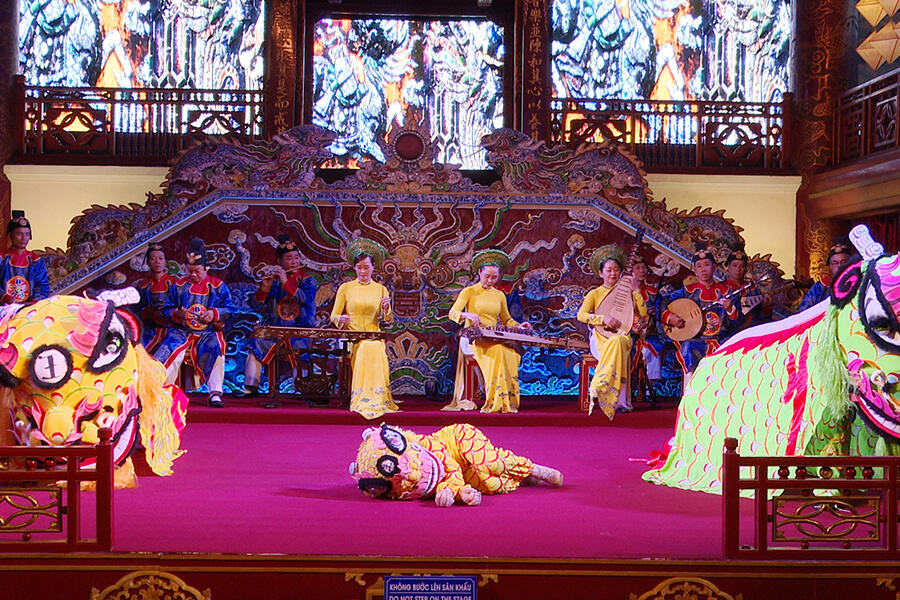Dance in Vietnam embodies a myriad of stories, each step a brushstroke painting the vibrant canvas of the country’s cultural identity. In this land steeped in unique traditions, while there isn’t a singular dance declared as the national emblem, there exists a colorful array of dances intricately intertwined with the diverse history and customs of various regions and ethnic groups.
Journeying through Vietnam’s rich cultural tapestry unveils a vibrant spectrum of traditional dances that breathe life into the country’s history and local customs. From the highlands to the coastal plains, each dance encapsulates a unique narrative, an artistic expression that resonates with the soul of the people and their ancestral heritage.
Delve into the tapestry of Vietnamese cultural tourism to discover the top 10 traditional dances that serve as poignant reflections of the nation’s cultural richness. These dances beckon with stories of ancient traditions, offering a deeper understanding of Vietnam’s heritage, drawing travelers into the enchanting tapestry of the country’s diverse cultural legacy.
traditional dance in VietNam
Sap dance in VietNam
Enlivening the cultural tapestry of Vietnam, the Sap dance is a distinctive folk dance treasured by the Thai people residing in the serene landscapes of the country’s northwest. Embraced during joyous occasions and spring festivals, this traditional dance unfolds as a spectacular and unique celebration.
Preparation for this traditional dance is a meticulous affair, with villagers assembling two robust and lengthy bamboo trees, serving as the foundation. A series of smaller bamboo pairs are meticulously arranged, intricately interlocking to create a captivating framework. The primary dancers—usually boys and girls from the village—are grouped into two teams, each assigned distinct roles. One team maintains a steady rhythm by clapping the bamboo, while the other team, with nimble agility, leaps and navigates the bamboo framework. The intricate tempo begins slow but gradually quickens, elevating the challenge for the dancers, a distinctive feature not commonly witnessed in other traditional Vietnamese dances.
As the dancers take center stage, each holds a long scarf, twirling and bouncing with graceful finesse within the bamboo construct. Their movements are a testament to agility and flexibility, transitioning seamlessly in horizontal, vertical, diagonal, and circular patterns—all impeccably synchronized to a rhythmic cadence. Precision is key, ensuring that as the bamboo structures collide, the dancers navigate without impediment, an awe-inspiring display of skill and artistry.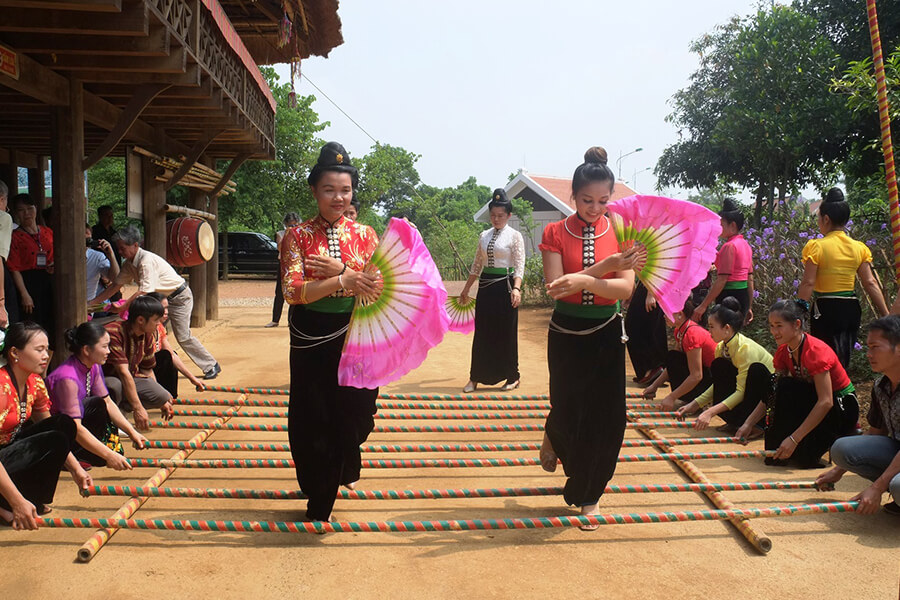
The Sap dance isn’t just a revelry; it’s an occasion for village unity and merriment. Beyond the vibrant spectacle, it provides an avenue for the young to forge connections and courtship, fostering an environment where relationships blossom amidst the exuberance of the dance. In this intricate tapestry of tradition, the Sap dance stands as a unique blend of cultural celebration and an enchanting stage for the hearts to entwine.
Khen dance in VietNamese
Resonating through the Northern mountainous landscapes of the H’Mong people in Vietnam, the Khen emerges as more than just a musical instrument; it’s an embodiment of their spiritual expression and a conduit for communicating their deepest emotions.
This ancient wind instrument transcends mere melodies; it becomes a medium for the H’Mong people to articulate their desires, dreams, and link with the spiritual realm. Its reverberation holds significance in pivotal life moments. At weddings, the mellifluous notes of the Khen serve as a parental farewell to their daughter, accompanying her transition to her new abode. During funeral rites, its mournful tunes echo sentiments of compassion and longing for the departed.
The Khen dance, an integral facet of this traditional practice, transcends musical performance; it becomes a dance of artistry and skill. A proficient Khen player seamlessly intertwines movement with melody. Each movement—whether a shrug, a swing, a turn, or even a captivating roll upon the earth—melds with the artful rendition of the Khen’s song, creating a mesmerizing choreography. In this dance, speed is a measure of skill, a testament to the dancer’s mastery.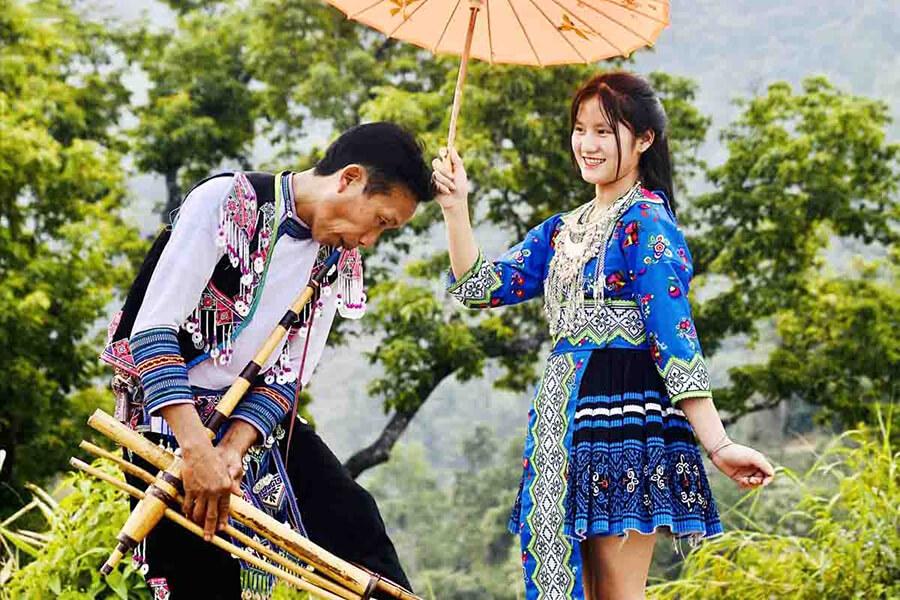
Within the dance, a union of sound and movement occurs, a symphony of rhythms intertwining with the fluid, rhythmic motion of the dancers. Viewers are immersed in the rich tapestry of the Khen’s variations while witnessing the dancers’ graceful and harmonic movements.
The Khen dance, beyond being a mere performance, is a display of love, resilience, and the indomitable spirit of the H’Mong people. It’s a spirited celebration of love and a portrayal of the H’Mong man’s strength and determination. In this ancient art, tradition, sound, and movement converge to create a vibrant spectacle that echoes the cultural depth and fervor of the H’Mong people.
Xoe dance – one of the Vietnamese traditional dances
Emanating from the creative spirit of the Thai community in Vietnam, Xoe dance is a cultural masterpiece, a collective celebration that embodies the soul and essence of communal life. This traditional dance transcends boundaries, embracing everyone—youth and elders, locals and visitors, weaving a vivid tapestry of cultural exchange.
Set against expansive landscapes, the Xoe dance unfolds in vast open spaces, fostering an unrestricted expanse for participants. The dance’s grandeur unfolds with the crowd size, the wider the circle, the more vibrant the dance. In instances where space is limited, the ingenious solution emerges: the circle splits into concentric rings, with a focal point often marked by a jar of wine or a dancing fire. The circles move in mesmerizing synchrony, one clockwise, the other in an elegant counter-motion, evoking a spirited display of unity.
Amidst the rhythmic movements, this communal dance transcends mere steps—it serves as a bond that unites individuals, fostering relaxation, exhilaration, and reinforcing the fabric of village and social relationships. The days dedicated to this art form are more than just dances; they are moments of connection, strengthening the bonds within the community.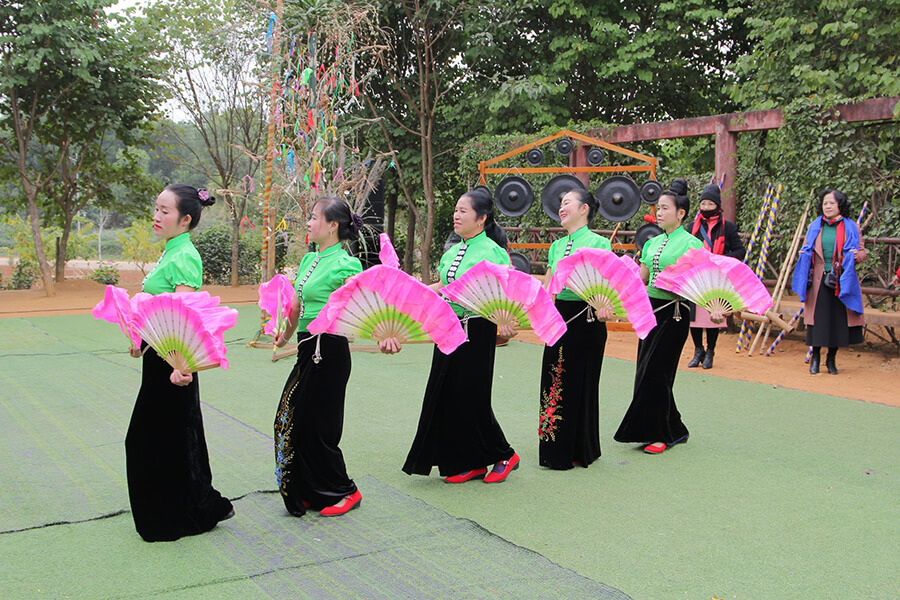
The Xoe dance, beyond being a mere performance, is an emblem of togetherness and a synthesis of life experiences and creative wisdom. This dance bridges the gap between locals and visitors, inviting all to partake in the cultural richness of Vietnam’s Northwest. It’s a cultural gateway, offering a glimpse into the lives and traditions of the Thai people, thus enriching not just Vietnamese culture but also contributing to the vivacity of Vietnam’s folk dance heritage. In the rhythmic cadence of the Xoe dance, a vibrant mosaic of traditions, stories, and unity comes alive, an ode to the spirit of community and the richness of Vietnam’s cultural tapestry.
national dance in VietNamese
Bell dance in VietNamese
Within the sacred rituals of the Dzao people in Hoa Binh province, the bell dance stands as a central and exclusive feature, an age-old tradition that bridges the past with the present. Rooted deeply in their cultural essence, this dance unfolds as a collective endeavor, a symphony of rhythm, melody, and storytelling.
Participation in this dance requires the presence of both men and women, ideally in trios, though more dancers are always welcomed. Each dancer, as they gracefully move to the beat, wields a delicate bamboo stick in their left hand and a resonant bell in their right. Guided by a conductor, they harmoniously count the beat while singing age-old songs that echo the narratives of settling new lands, marriage, and the blessings of new life.
This dance, unique among Vietnamese traditional dances, is distinguished by the presence of the small bronze bell, which acts as the dance’s central element. This melodious bell is accompanied by an array of auxiliary props, such as drums, erhu, and flute, coming together to craft a vibrant, resonant music that infuses each step with an indomitable energy.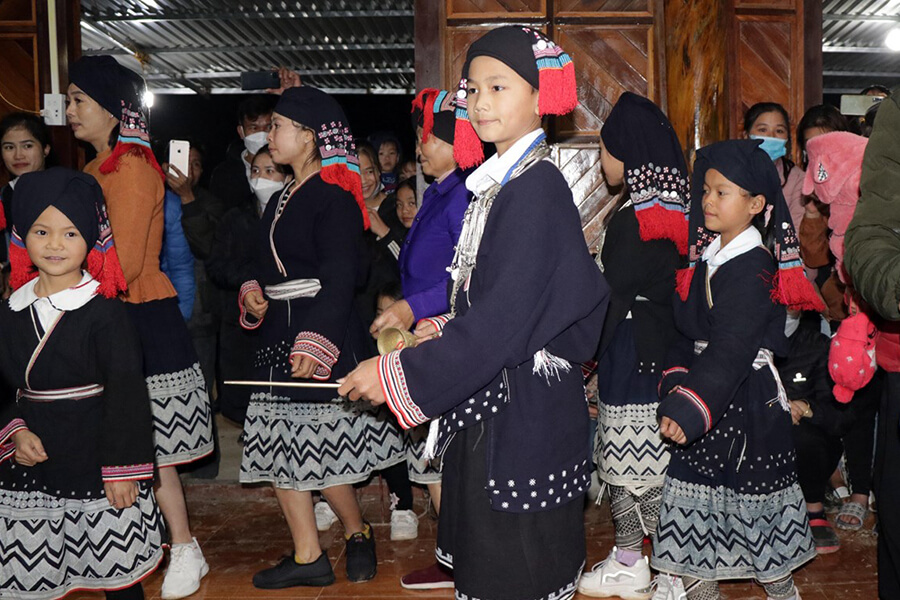
For the Dzao people, these dances are more than mere performances; they are an inseparable part of their cultural heritage. With the evolution of community tourism, these dances now find a broader stage, welcoming international audiences, sharing the cultural richness of the Dzao traditions. Visitors are captivated by the performance, not just during significant holidays but also throughout the year, unveiling the traditions of the Dzao people.
To witness this enchanting dance, one must venture to the Sung hamlet in Cao Son commune, Da Bac district, Hoa Binh province. Here, the spirit and vitality of the Dzao culture come alive, offering a unique and unforgettable glimpse into the heart of Vietnamese tradition.
Embracing the rhythms and narratives of these traditional dances isn’t just a mere observation; it’s an immersion into the diverse landscapes and cultural richness that each region of Vietnam possesses. Each dance tells a story, not just of the present, but of a heritage deeply rooted in the past and cherished for the future generations.
Gong dance – one of the Vietnamese dances recognized by UNESCO
In the heart of the Central Highlands, the resonating beat of gongs transcends mere music, embodying a cultural legacy recognized and treasured by UNESCO as a masterpiece of humanity’s intangible heritage. Spanning across five provinces and embraced by a multitude of ethnic groups, the gong is more than a musical instrument—it’s a living chronicle interwoven into the daily lives of the people here.
The gong, crafted from a copper alloy often blended with silver or black copper, echoes the essence of life for the ethnic groups of the Central Highlands. It’s a companion to their daily rituals, symbolizing each step of the human journey.
Embedded in every festival within the Central Highlands, the gong dance is an essential element, a vibrant and rhythmic tribute to daily existence. Dancers synchronize their movements with the resonating gong beats, executing short, rhythmic steps and fluid motions, swaying and bouncing in unison. Their elegant movements tell stories—depicting everyday life, work activities, expressions of love, and even fleeting moments of anger.
The gong dance transcends beyond mere steps; it’s a spirited celebration that breathes life into the core of the community. Each motion, each sway, unfolds a narrative of existence, conveying the nuances of daily life in this richly cultural region. As the vibrant sound of gongs fills the air, boys and girls move in a coordinated counter-clockwise circle, painting an animated picture that mirrors the tapestry of the community’s existence.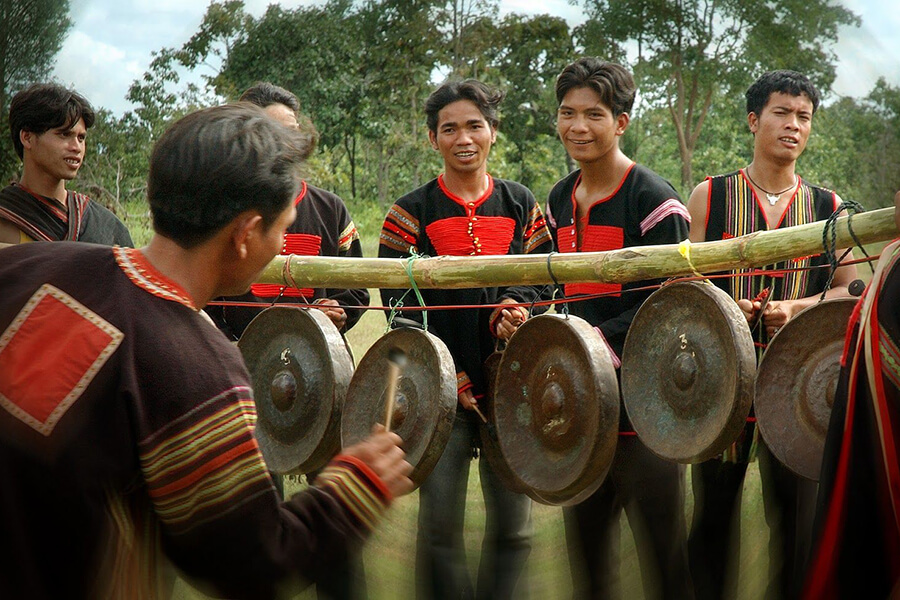
In sync with the gong dance is the exuberant Gongs festival, a jubilant affair unfurling over a couple of days, often celebrated from March to December. As the resonant gong sounds echo, the people of the Central Highlands congregate around fires and jars of straw liquor, weaving an exhilarating celebration—dancing, singing, and embracing the jubilant spirit that animates their cultural existence.
In this land where the gong reverberates, it’s not just a dance or festival; it’s a symphony of life, a cultural narrative echoing through the vibrant rhythms and melodies, captivating and uniting the community in the heart of the Central Highlands.
Cham dance of Cham people in VIetNam
In the historical remnants of Champa, a kingdom that once thrived in Central Vietnam, the Cham people, despite the kingdom’s decline, have preserved their rich cultural heritage, dispersing across different regions within Vietnam. Concentrating primarily in provinces like Ninh Thuan, Tay Ninh, Dong Nai, Ho Chi Minh City, Southwest Binh Thuan, and Northwest Phu Yen, the Cham community upholds its traditions, particularly through the revered art of Cham dance.
The Cham dance is a cultural cornerstone within the spiritual and social fabric of the Cham people, intimately intertwined with significant festivals such as Rija Nùgar, Kate, and Rija Praung. These festivities serve as poignant occasions for the Cham to pay homage to the architects of their nation, venerating the deified kings who shaped their history. In this rhythmic spectacle, the Cham dancers are accompanied by a symphony of traditional ethnic instruments, each weaving their own narrative within the harmonious chorus. Among them, the Ginang drum takes center stage, its resounding beats echoing the soul of the Cham people.
Distinct and multifaceted, the Cham dance unfolds in two pivotal parts, each representing diverse narratives and purposes. One facet is intricately entwined with religious practices, a solemn tribute to spiritual beliefs during sacred ceremonies. The other facet finds its place in everyday life, serving as an essential element of community gatherings, catering to the collective need for entertainment and bonding.
These dances are not mere spectacles but conduits for distinct cultural expressions. The formal dances are steeped in reverence, often invoking images of gods and are a conduit for prayers for peace and well-being. In contrast, the festival dances are more closely aligned with everyday objects and the lifestyle of the Cham people, capturing the essence of their community and its customs.
Among the array of dances, three notably popular folk dances stand out—the peacock dance, known for its vibrant fan movements; the water team dance, capturing the fluid essence of water; and the towel dance, symbolizing elements of daily life. Each dance is a living embodiment of the Cham people’s heritage, offering an intricate glimpse into their culture, traditions, and vibrant spirit.
artistic dance in VietNamese
Conical hat dance in VietNam
Enter the realm of the Conical Hat dance, a lively tribute to the vibrant essence of the Mekong Delta in Vietnam. As the dancers move gracefully, they become ambassadors guiding you through the enchanting landscapes of this land—where rivers weave stories of an abundant and harmonious existence.
This traditional dance mirrors the spirit of the Mekong Delta, a place characterized by its serene charm and warm-hearted inhabitants. The performance embodies the very essence of this peaceful setting, resonating with joy and enthusiasm that perfectly aligns with the spirit of the region. It’s a vibrant depiction that transports you to the lively Phung Hiep floating market, where a sea of boats ebbs and flows, or the iconic bamboo monkey bridges that gracefully connect the verdant banks of the creeks. The dance can evoke memories of bustling markets in Sa Dec City, Soc Trang Province, and Can Tho City, overflowing with an array of colorful fruits and vibrant energies.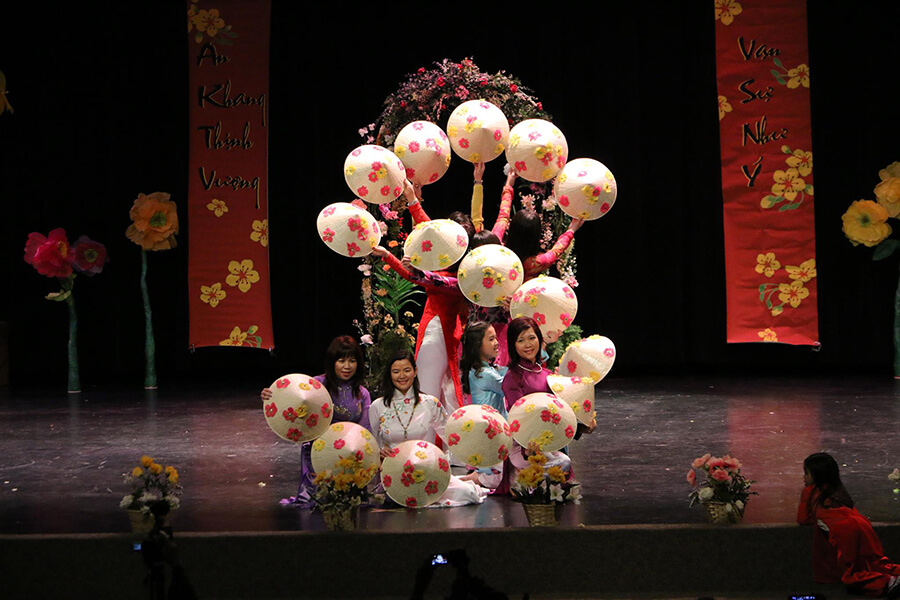
Adorned in the traditional Southern dress called Ba Ba, the dancers exude the grace and elegance characteristic of Southern Vietnamese women. Paired with the Ba Ba is the iconic Vietnamese conical hat—a symbol of simplicity, lightweight, and a ubiquitous accessory among the Vietnamese people. These props, steeped in tradition, infuse the dance with a deep cultural resonance. The background music accompanying this dance resonates with heroic melodies, evoking the spirit of the nation and an unwavering love for the country.
The Conical Hat dance serves as a testament to the cultural identity of the Southern region and, in a broader spectrum, encapsulates the spirit of the Vietnamese people. It’s not merely a performance but a vibrant ode to the ethos and richness of the Mekong Delta, embodying the essence of its landscapes, traditions, and the spirited hearts of its people.
Lion dance in VietNamese
Amidst the grandeur of Vietnamese festivals, whether it’s the Lunar New Year or the jubilant celebrations at weddings, a captivating sight unfolds—a performance steeped in cultural heritage, the mesmerizing lion dance. This cherished dance embodies luck, happiness, and the promise of prosperity, resonating with the heart of the people and becoming an integral part of Vietnamese traditions.
The lion dance intertwines three iconic elements—the mystical unicorn, the animated lion, and the resplendent dragon, each symbolizing auspiciousness and joy. Evolving from a tradition into a beloved street folk art, this dance has found a special place in the hearts of the Vietnamese people.
The performances are tailored to suit the essence and ambiance of diverse celebrations. Lion dance troupes adapt their repertoire to encapsulate the spirit of each festival, selecting songs that resonate with the occasion’s significance. As the dance unfolds, individual parts of the performance can be presented separately, or combined to showcase mesmerizing ensembles such as the lion dance with the unicorn or the dragon.
An essential figure in this lively dance is Mr. Dia, the earth god revered for safeguarding the life and prosperity of a locality in the Vietnamese ethos. Portrayed alongside the lion group, Mr. Dia symbolizes the harmonious bond between humanity and the animal realm, a testament to the Vietnamese appreciation for coexistence and balance in the world.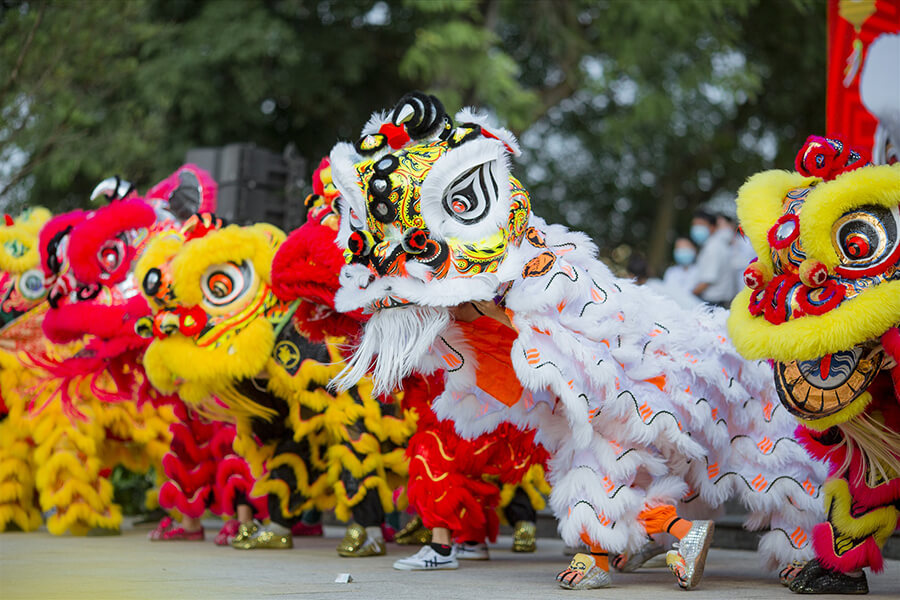
Adding to the spectacle is the resounding beat of the drums, which contributes a dynamic rhythm to the performance. The tempo varies, at times fast, at times slow, weaving a pulsating tapestry that complements the animated movements of the dancers.
The lion dance is not merely a visual spectacle; it’s a cultural symphony resonating with the ethos of luck, prosperity, and communal joy. It intertwines history and artistry, enchanting audiences and embodying the celebratory spirit at the heart of Vietnamese traditions.
Xuan Pha folk dance in VietNam
Immersed in the mists of time, the exact genesis of the Xuan Pha folk dance remains veiled in mystique, a cherished relic believed to have emerged from the annals of antiquity. This captivating dance vividly recounts an ancient tale, echoing the grandeur of five neighboring nations—Hoa Lang, Tu Huan, Ai Lao, Ngo Quoc, and Xiem Thanh—as they presented their tribute to the erstwhile King of Vietnam.
As with many Vietnamese traditional dances, the artistry of Xuan Pha folk dance seamlessly integrates music, song, and dance, with the latter reigning supreme. These performances meticulously adhere to intricate rules and specific narratives, each segment unfolding with precision and adherence to the set scenarios. Dancers partake in a choreography that involves a symphony of gestures, employing hand movements, leg postures, and a plethora of props—flags, paper fans, and spears—all choreographed to perfection. The dance’s signature lies in the vigor of its movements—robust gestures, animated headshakes, and subtle leaps that resonate with the vibrant storytelling.
Marking the rhythms of tradition, the village of Xuan Pha in Tho Xuan district converges on the 9th and 10th of the February lunar month to celebrate their revered village festival. Here, within the embrace of their age-old customs, the community gathers in joyous revelry, embracing their heritage through the evocative and entrancing art of the Xuan Pha folk dance.
Hue royal court dance – top 10 Vietnamese traditional dances
Nestled within the historical tapestry of Vietnam, Hue stood as the sanctuary of the nation’s cultural opulence. The majestic dance of the Hue royal court, a legacy deeply entrenched in the annals of ancient Hue culture, holds an esteemed position in the heritage of this illustrious city. With UNESCO’s recognition of Hue royal court music as an Intangible Cultural Heritage of Humanity, the splendor of royal dance ascended to an exalted status.
Across Vietnam’s extensive history, the corridors of power reverberated with enchanting dances, where elegant movements amused kings and mandarins alike. These dances evolved across dynasties, with the peak of this regal artistry witnessed during the Nguyen Dynasty (1802 – 1945).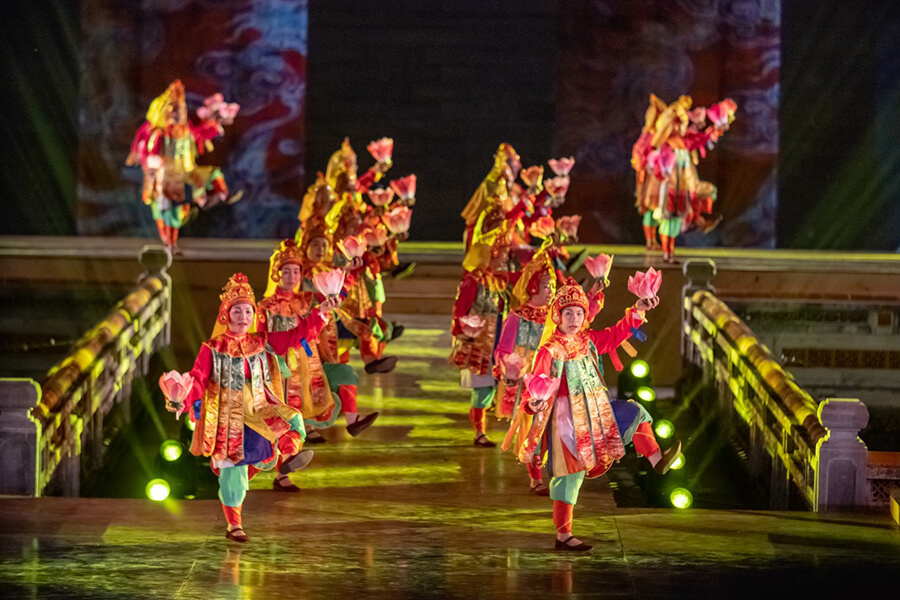
Hue court dance, born from humble folk traditions, metamorphosed into an art form that demanded unparalleled professionalism in every facet. A grand royal performance unfolds through multiple scenes, each exquisitely orchestrated with a plethora of dancers, predominantly graceful maidens. These dancers, bedecked in resplendent and elaborate costumes, adorned meticulous makeup and intricate hairstyles. Set against standards higher than other Vietnamese traditional dances, the execution of every movement in the Hue royal court dance was an embodiment of flawless precision, allowing no room for error. An indispensable accompaniment to this artistry is music, merging seamlessly with the enchanting choreography. Hence, the dancers of the Hue Royal Court were not only exquisite dancers but also accomplished vocalists, expected to sing melodiously as they adorned each movement with grace.
For those eager to witness this treasured gem of Vietnamese tradition, the Hue Royal Court Traditional Art Oper within the Imperial City of Hue is the hallowed ground where the opulence of this regal dance unravels, offering a glimpse into the majestic legacy of the Hue royal court dance.

